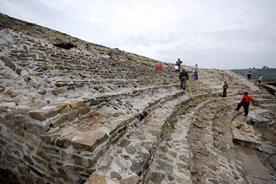
The second season from the Project for Conservation, Restoration and Reconstruction of the Eastern Half of the Auditorium of the Roman Theatre took place during September, October and November. The work continued with conservation and reconstruction of the remaining vaults of ima cavea (lower segment of the auditorium) which have not been conserved in 2013. The vaults between the radial walls were built from stones and lime mortar and they rested on mounds of soil brought to the theatre from a different location. The reconstruction of the vaults was done with the usage of authentic material such is the local sandstone discovered during the excavations, and the application of new, lime based mortar.
After the vaults were consolidated, the next step in the conservation process was the reconstruction of the beddings for the marble seats. The work included two stages. During the first stage only the facings of the beddings were reconstructed in order to have the outline of every single row. The second stage meant restoration of the slopes between the facings. The reconstruction of the beddings was based on the original preserved parts and it was done with amorphous sandstone, white marble flints and lime based mortar. Twelve rows out of the original eighteen were reconstructed this season. The highest six rows rested on top of the vault above the central circular corridor. Their reconstruction will follow the restoration of the vault, planned for 2015. During this season, the restoration team managed to conserve the stairs in the western lateral room and fully reconstruct the stairs in the eastern.
At the same time with the conservation process, excavations were carried in the central circular corridor, as well as the eastern radial corridor. The new results brought significant information for the construction of the theatre and its function during the 2nd and 3rd centuries, as well as new information for the period of the abandonment which happened at the end of the 4th century. After the Theatre went out of use, the walls and the corridors were used in the newly erected Late Antique buildings which occupied the area.
The construction of the Theatre in Stobi started at the end of the 1st century AD, but it was fully finished during the first half of the 2nd century. The diameter of ca. 90 metres, the capacity of 7 600 spectators and the high level of preservation include the Stobi Theatre among the most important and most grandiose monuments of the Roman architecture in the province of Macedonia.
The conservation project was financed with 1 600 000 MKD (26 000 EUR) by the Macedonian Ministry of Culture as part of the Annual Program for Projects of National Interest in 2014. This NI Stobi project was directed by architect Nikola Šentevski, senior conservator, Dr. Trajče Nacev, senior conservator and professor at Goce Delčev University and Goce Pavlovski from NI Stobi, director of the Theatre excavations.
For the photo album of the conservation process click here.
Related: The Theatre conservation project continues in spring, 2013